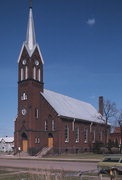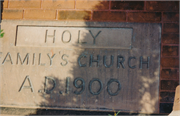Property Record
106 WILLIS AVE
Architecture and History Inventory
| Historic Name: | HOLY FAMILY CHURCH |
|---|---|
| Other Name: | Holy Family Church |
| Contributing: | |
| Reference Number: | 4356 |
| Location (Address): | 106 WILLIS AVE |
|---|---|
| County: | Ashland |
| City: | Ashland |
| Township/Village: | |
| Unincorporated Community: | |
| Town: | |
| Range: | |
| Direction: | |
| Section: | |
| Quarter Section: | |
| Quarter/Quarter Section: |
| Year Built: | 1900 |
|---|---|
| Additions: | |
| Survey Date: | 1982 |
| Historic Use: | church |
| Architectural Style: | Early Gothic Revival |
| Structural System: | |
| Wall Material: | Brick |
| Architect: | Henry Wildhagen |
| Other Buildings On Site: | |
| Demolished?: | Yes |
| Demolished Date: | 2001 |
| National/State Register Listing Name: | Not listed |
|---|---|
| National Register Listing Date: | |
| State Register Listing Date: |
| Additional Information: | A 'site file' exists for this property. It contains additional information such as correspondence, newspaper clippings, or historical information. It is a public record and may be viewed in person at the State Historical Society, Division of Historic Preservation. HISTORICAL STATEMENT: The history of Holy Family's Church is intimately tied to the early settlement of Poles in Ashland in the early 1880's. St. Agnes Catholic Church was already established when the first Poles reached Ashland in 1893, but within a very short time the problem of overcrowding developed. By 1893, there were enough Poles in Ashland to warrant a Polish mass which was said one Sunday per month; in 1894 this service was increased to two per month. By 1899, the Poles were authorized to have their own parish, but when the pastor of St. Agnes, Fr. Fabian Rechtisne, D.E.M., sought permission to expand St. Agnes School for more room, his request was denied. The bishop advised instead that the Poles should build their own church and school to correct the overcrowded conditions. Soon thereafter the now official Polish parish held its first services and plans were drawn immediately by Henry Wildhagen. The contractor was Dan Eagen and Donald and Company built the school and church in 1900. Architectural Statement: Holy Family Church is architecturally significant as a local example of Late Gothic Revival Church architecture and for its association with a well-known reputable Ashland architect, Henry Wildhagen. DESCRIPTION: The Red brick building with brownstone trim consists of a central nave with a tall central square tower with double gable roof and an octagonal spire above. An elaborate red brick corbel table surrounds the building that rests on a massive foundation that includes a 1900 cornerstone. Circular rose windows are placed in the tower's gable peaks and in the center of the tower's gable peaks and in the center of the tower's front facade. The three-part entry subordinates side entries to the protruding and larger central entry. Pointed arch windows are joined by brick pointed arches. Six large windows are on each side. The interior woodwork is intact but pained and features a dazzlingly colored system of piers and quatrefoil vaults. The church is 127' long and 53 feet wide. The tower is 132 feet high SIGNIFICANCE: Although exempt from the National Register because it is a religious property, Holy Family Catholic Church is significant as a locally rare example of Late Gothic religious architecture for its association with the reputable architect from Ashland, Henry Wildhagen and the builder, Donald and Company. The property is historically significant for its association with the settlement of the Poles in northern Wisconsin. For a discussion of Holy Family School, see ISF 12-21. Threatened with demolition in 1998. Red brick, Late Gothic Revival church has brownstone trim. |
|---|---|
| Bibliographic References: | Ashland Daily Press 8/26/1998. |
| Wisconsin Architecture and History Inventory, State Historic Preservation Office, Wisconsin Historical Society, Madison, Wisconsin |





